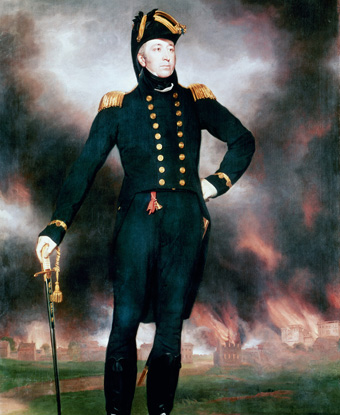Last updated: April 8, 2021
Person
George Cockburn

The Granger Collection
Admiral of the Fleet Sir George Cockburn (pronounced co-burn) was a second son of Member of Parliament and Scottish aristocrat Sir James Cockburn. A son in his position was expected to join the military, and so Cockburn did – attending the Royal Navigational School and enlisting in the Navy at the age of 9. He assisted as a Captain’s servant on several ships throughout the 1780s, eventually being made lieutenant at age 19, and took command of a vessel of his own in 1793.
Through service in the French Revolutionary Wars and the Napoleonic Wars, Cockburn was quickly promoted from lieutenant, to captain, and then commodore. When the War of 1812 began, Cockburn was promoted again to rear admiral, and sent to Bermuda to join Admiral Sir Alexander Cochrane in his attacks on the Americans.
Cockburn’s most lasting impression in the War of 1812 was the critical role he played in organizing raids along the Chesapeake under Cochrane’s orders, including raiding the towns of Havre de Grace, Hampton, and Frenchtown. This earned him a very bad reputation in the American press as a savage and warmonger. Cockburn reveled in this portrayal as he planned and executed the sack of Washington, D.C. in 1814. Although scrupulous in ordering soldiers to damage only public property, he took personal delight in destroying the offices of the National Intelligencer that had lampooned him. This victory earned him an appointment as a Knight Commander of the Order of Bath shortly before the war ended.
Following the War of 1812, and more military service in the Napoleonic Wars, Cockburn followed in his father’s footsteps and was elected as a Member of Parliament in 1818. He served as First Naval Lord for Parliament and executed extensive improvements to the weapons and skills for gunnery in the British naval fleet, and ensured they had the latest steam technology available.
